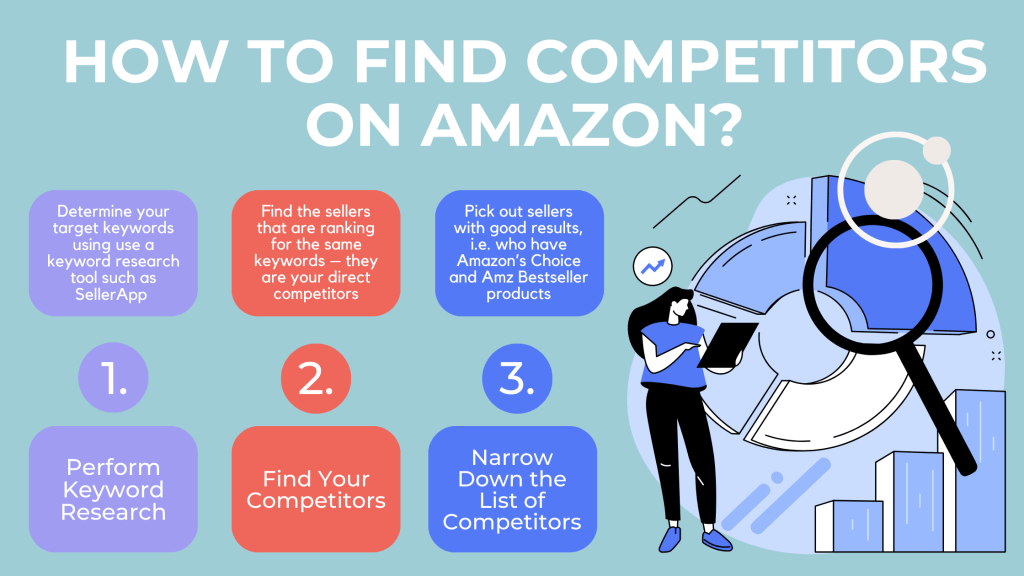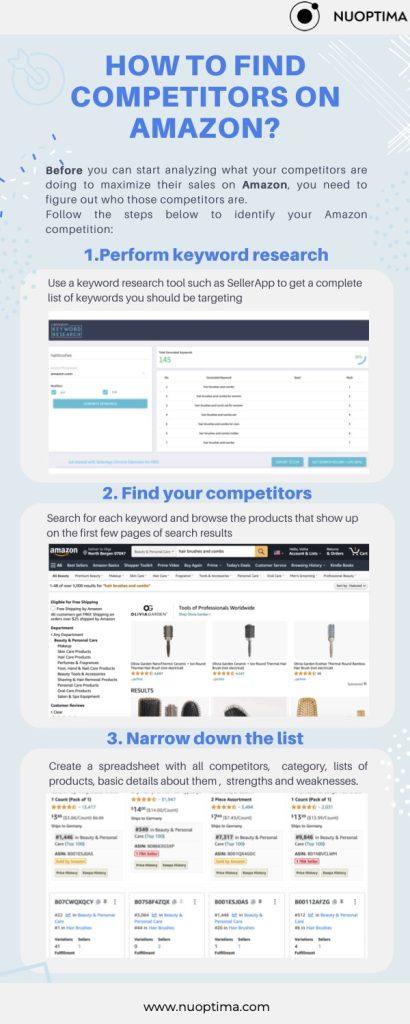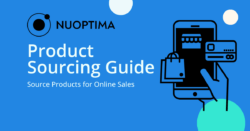Key points
- Amazon competitor analysis is a process during which you compile a list of your closest competition on the platform, choose the most prominent players, and take a detailed look into everything they do to attract customers and sell their products.
- Competitor analysis can help you find gaps in the market that you can fill with your products and understand how you can improve your Amazon listings and business strategy in general to attract buyers.
- You can identify your competition in the marketplace by searching for products that are similar to what you’re selling.
- Once you’ve narrowed down a list of competitors, you should examine their prices, product listings, reviews, websites, social media pages, ad campaigns, backlinks, and sales volumes.
With each passing year, competition on Amazon is becoming more and more cutthroat. It’s not surprising, given that around 2,000 new sellers register on the platform every day. However, this means that sellers need to put in a lot more effort to keep their offers competitive on the platform. One tool you can use to gain an advantage over other sellers is competitor analysis. In this article, we will explain what Amazon seller competitor analysis is, how it can benefit your business, and how you can perform it.
Advantages of performing Amazon competitor analysis
Competitor analysis is often a boring, tedious, and time-consuming task. So at some point, you may find yourself wondering if it’s really worth all the work and time. The answer is yes! Researching your Amazon competition can have many significant benefits, as it allows you to:
- Ensure that your prices are competitive
- Get ideas for how you can make your products stand out from the competition
- Understand how your listings are performing compared to your competitors
- Choose which products to sell
- Find and fill gaps in the market
How to find competitors on Amazon?
Before you can start analyzing what your competitors are doing to maximize their sales on Amazon, you need to figure out who those competitors are. Follow the steps below to identify your Amazon competition:

Perform keyword research
To figure out which sellers you’re competing against on Amazon, you first need to determine your target keywords. Let’s say you’re selling hairbrushes on Amazon. Your target keywords will be the words people will likely search for when they visit the marketplace. Even though sometimes you can figure out keywords intuitively, it’s a much better idea to use a keyword research tool such as SellerApp to get a complete list of keywords you should be targeting.

Find your competitors
Once you have a list of all the keywords you want to rank for, you need to find the sellers that are ranking for the same keywords, as they are your direct competitors. To do this, you need to search for each keyword and browse the products that show up on the first few pages of search results. Please note that it’s unnecessary to browse all the products, as there will likely be thousands of them. You should pay the most attention to sellers whose products are located at the top of search results.
Finally, compile a list of all sellers whose listings are in these results and repeat the process for other keywords on your list. Keep in mind that you can also perform this search on Google to find competitors who are not on Amazon.
Narrow down the list
Once you complete all the steps described above, you will be left with a long list of competitors. However, it’s impossible to research all of them thoroughly, so you should go through the list and pick out the sellers that are getting good results. For instance, you should definitely include all the sellers who have Amazon’s Choice and Amazon Bestsellers products, as these are the top listings in each respective niche. You should also pay extra attention to sellers with multiple listings on the first page of search results.
Once you’ve narrowed down your list, you should organize all sellers into three categories. The first category will contain your primary competitors. These are companies that sell products that are very similar to yours or target the same audience as you. The secondary competitors group will sell similar products to a different audience, or they could sell slightly higher or lower-end products than you. Finally, the tertiary competitors group will contain companies that sell products that are somewhat related to what you’re selling. For instance, if you’re selling pots, this category could contain companies that sell skillets.
In the end, you should have a spreadsheet with all competitors, their category assignments, lists of products they sell, and basic details about them, including strengths and weaknesses.
Analyze competing sellers on Amazon
Once you have a complete list of all your competitors, you should start analyzing them. There are numerous things you should specifically pay attention to:
Product title
Start by examining the titles competing sellers are using for their products. Compare titles of different products and take note of things that could be added or removed from the titles to improve them. You should also pay attention to the keywords other sellers use in the title to describe their products.
Product images
Images are one of the most essential parts of any Amazon listing, as people can’t see or touch your product in person. Therefore, you should strive to obtain the highest possible quality images taken at the best angle that show the product in the most detail. Examine the photos of your competitors’ products and make a note of things that do and don’t work. It’s also a good idea to think about how you can use images to make your product stand out from the rest.
Bullet points
Bullet points often contain the most crucial selling points of the product, so you should pay extra attention to them. For instance, you can see what advantages of their products your competitors highlight and find ways to counter those advantages in your own bullet points.
Product description
By reading a large number of product descriptions, you will be able to figure out what information a good description should and should not include, what the best tone for a description is, etc.
Questions and answers
This section of product listings can provide lots of valuable information to you as the seller. First of all, you will see what questions customers ask most frequently. You should highlight this information in your product title, bullet points, and/or description. You can also see whether other sellers take time to answer customer questions.
Prices
Price always plays a huge role in a buyer’s decision-making process. Ideally, you want to sell your product at a slightly lower price than your competitors. And if the product’s quality is a little better than your competitors’ products, its price should be the same or slightly higher. Keep in mind that you need to maintain a high enough price to ensure that you can make a profit and not lose money on your business.
It’s also a good idea to look at the price history, as most sellers use repricing software to adjust the price of their products.
Monthly sales
Some Amazon analytics software allows you to see how many sales your competitors are making each month. This information can help you understand if there’s a significant amount of demand for a product you’re planning on selling and how much money your competitors are able to make in terms of profit each month.
Customer reviews
Amazon product reviews can provide you with a trove of information about your competitors. Pay extra attention to negative reviews, as they will show you precisely what you need to do to beat your competition. Just make a note of all the things reviewers didn’t like about a competing product and use this information to improve the product you’re offering.
Explore keywords
Just like you, your competitors are also trying to optimize their listings for target keywords, so you should carefully examine their listings to see if they are doing something you’re not. You can do this manually, but the entire process will go much quicker if you use a keyword research tool such as Keyword Scout.

Backlinks
Getting backlinks for your Amazon product listings won’t help them rank higher in Amazon search results. However, it will help them rank higher on Google. Figuring out what strategies your competition is using to build backlinks can help you determine what you need to do to grow your business in the long term, as link building doesn’t give immediate results, but it can definitely help grow your online presence.
Ad campaigns
Before you start running ads on Amazon, you need to analyze your competitors’ Amazon ad campaigns. You can only remain competitive if your ads cost the same or slightly more per click than what other sellers in your niche are paying.
You can use programs such as Cerebro to analyze other sellers’ Amazon ad campaigns and find out what keywords they are targeting with ads and the search volumes of those keywords.
You should also find out where other sellers are running Google Shopping ads. Simply enter one of your primary keywords on Google and see whether you see any ads for Amazon products in the Google Shopping ads section. If you don’t, you can take advantage of this situation and start running these ads for your own products. However, this could be a risky move, as your competitors might be staying away from Google Shopping ads for a reason.
Website
Many of your competitors will likely have their own websites in addition to selling products on online marketplaces. You should examine these websites paying attention to their design and user interface, the types of forms and pop-up windows used to provide information, offer discounts, request email information, etc.
If you already have a website for your brand or are planning on creating one in the future, you can consider the downsides of other sellers’ websites and improve on those things on your website.
Social media
Many competitor brands may have pages on various social media platforms, so you should do the same. This is especially important if you’re targeting a younger demographic that spends a lot of time on these platforms. Social media pages can be a great source of organic traffic to your Amazon listings.
When browsing your competitors’ social media accounts, you should note the platforms where the accounts are located, the type of information these companies are posting, the frequency with which they post, and the amount of engagement each post gets on average.
Use the information you’ve gathered
Once you complete your competitor analysis, you will have a massive amount of information. Now, you need to make sense of all that data and figure out how to use it to your advantage. There are several things you can do with it, but here are a couple of ideas to try:
Find or create the right products to see
Once you’ve analyzed all the information about the products other Amazon sellers are offering, you should be able to see gaps in the market. You can use this data to create or source products that will fill those gaps. If you can find some niche where customer needs are not fulfilled and find a way to meet them, your business will likely thrive because your products will have lots of demand without facing any competition.
Price your products appropriately
Once you know how your competitors price their products, you can set competitive prices on your inventory. You should also consider using repricing software to ensure that you’re offering the best prices possible at any given moment. Since most sellers use this software for their listings, competing with them without utilizing these methods will be challenging.
Optimize your keyword strategy
After conducting Amazon competitor analysis, you will have a good understanding of the products people are searching for, so you can build up your inventory to include the products customers search for. Plus, you will clearly understand all the keywords and advertising methods you should be using.
Beat the Competition with Epic Amazon PPC Ads
After examining your competitor’s ads, you need to start running your own PPC campaign. To get the best results, hire an Amazon PPC expert. They can use the information you’ve gathered and conduct their own comprehensive competitor analysis to develop a strategy that will generate some serious revenue. A decent Amazon PPC agency will research the best keywords, craft compelling ads, and constantly tweak and optimise to ensure you get the best ROI possible.
Expand your business outside Amazon
Finally, you should consider creating a website and social media pages for your brand to grow your business outside Amazon. Keep in mind everything you’ve learned from your research and avoid making the same mistakes your competitors made with their social media accounts and websites.
Final thoughts
While Amazon competitors analysis is an extremely time-consuming and labor-intensive task, once you complete it, you should have a clear understanding of your niche, its top performers, reasons why those companies were able to become so successful, and all the strategies you should be using to become a leader in your market.
Fortunately, you don’t need to do all that work researching the competition yourself if you hire an Amazon growth agency. Sign up for a free discovery call with one of NUOPTIMA’s top Amazon experts today, or leave your email, and we will reach out to tell you all about our services.



